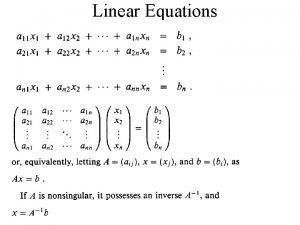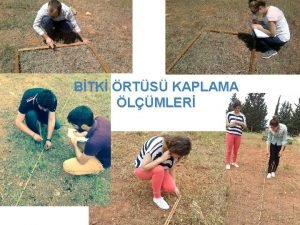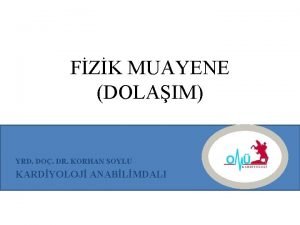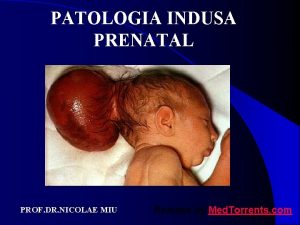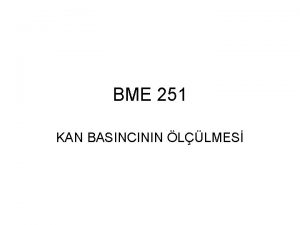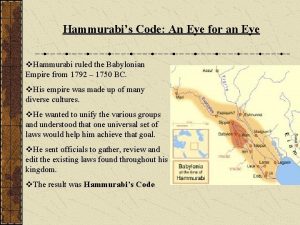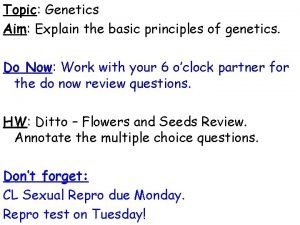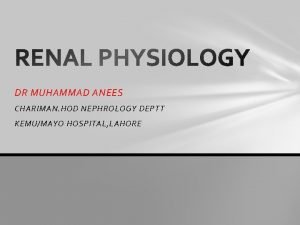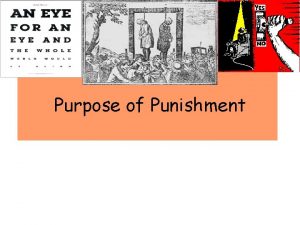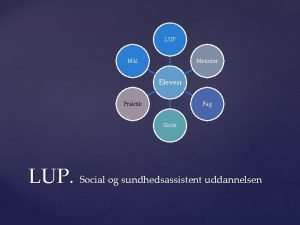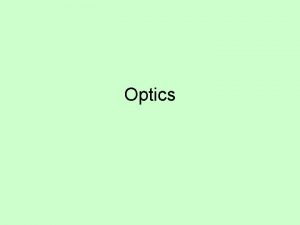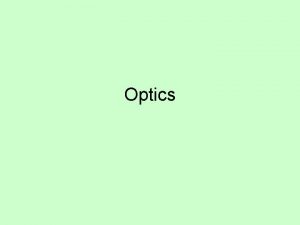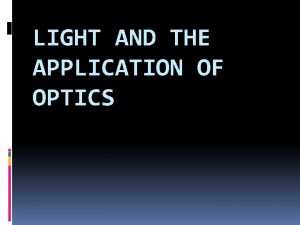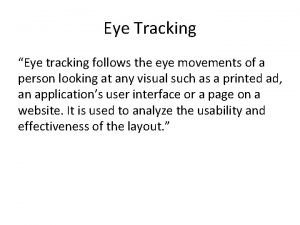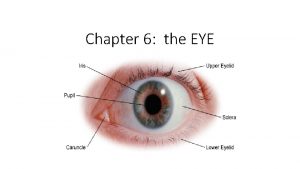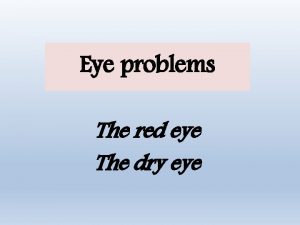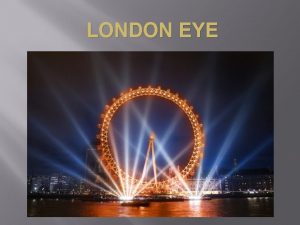Optics instrumens l Eye l Lup l Microscoope

















- Slides: 17


Optics instrumens l. Eye l. Lup l. Microscoope l. Teropong

The Eye – Close-up of the Cornea

The Eye l l The normal eye focuses light and produces a sharp image Essential parts of the eye: l l Cornea – light passes through this transparent structure Aqueous Humor – clear liquid behind the cornea

The Eye – Parts, cont. l The pupil l l A variable aperture An opening in the iris The crystalline lens Most of the refraction takes place at the outer surface of the eye l Where the cornea is covered with a film of tears

An intuitive way to view eye corrections Near-sighted eye is elongated, image of distant object forms in front of retina Add diverging lens, image forms on retina Far-sighted eye is short, image of close object forms behind retina Add converging lens, image forms on retina

The Eye – Near and Far Points l The near point is the closest distance for which the lens can accommodate to focus light on the retina l l l Typically at age 10, this is about 18 cm The average value is about 25 cm It increases with age l l Up to 50 cm or greater at age 60 The far point of the eye represents the largest distance for which the lens of the relaxed eye can focus light on the retina l Normal vision has a far point of infinity

Nearsightedness (Myopi)= Rabu jauh l l l Also called myopia The far point of the nearsighted person is not infinity and may be less than one meter The nearsighted person can focus on nearby objects but not those far away

Correcting Nearsightedness l l A diverging lens can be used to correct the condition The lens refracts the rays away from the principal axis before they enter the eye l This allows the rays to focus on the retina

l Eyeglasses with concave lenses used overcome nearsightedness must have lens strength (P) = kekuatan lensa : Pr = Punctum Remotum of eye ( cm) = titik jauh mata

Farsightedness ( rabun dekat/ hypermetropia) l l Also called hypermetropia The near point of the farsighted person is much farther away than that of the normal eye The image focuses behind the retina Can usually see far away objects clearly, but not nearby objects

Correcting Farsightedness l l A converging lens placed in front of the eye can correct the condition The lens refracts the incoming rays more toward the principal axis before entering the eye l This allows the rays to converge and focus on the retina

Farsightedness eyes have the Punctum Proximum greater than 25 cm and the punctum remotum at unlimited. Eye glasses with convex lenses used to overcome Farsightedness must have the lens strength : Pp = Punctum Proximum = titik dekat

Presbyopia and Astigmatism l Presbyopia (literally, “old-age vision”) is due to a reduction in accommodation ability l l l The cornea and lens do not have sufficient focusing power to bring nearby objects into focus on the retina Condition can be corrected with converging lenses In astigmatism, light from a point source produces a line image on the retina l l Produced when either the cornea or the lens or both are not perfectly symmetric Can be corrected with lenses with different curvatures in two mutually perpendicular directions

Diopters l Optometrists and ophthalmologists usually prescribe lenses measured in diopters l The power P of a lens in diopters equals the inverse of the focal length in meters l. P = 1/ƒ

Student Activity l Anton’s retina is 2. 5 cm behind the lens, which has a minimum focal length of 2. 6 cm. 1. What does the focal length fcl of her contact lens need to be? (a) 65 cm (b) -65 cm 2. 5 cm feye = 2. 6 cm (c) -0. 1 cm 2. What is the power Pcl of the contact lens? (a) 1. 5 D (b) -1. 5 D (c) 1000 D

Compound Microscope l A compound microscope consists of two lenses l l l Gives greater magnification than a single lens The objective lens has a short focal length, ƒo< 1 cm The eyepiece has a focal length, ƒe of a few cm
 Lup digunakan untuk
Lup digunakan untuk Difference between ray optics and wave optics
Difference between ray optics and wave optics Reflection and refraction venn diagram
Reflection and refraction venn diagram Lup slovac
Lup slovac Ranson kriterleri
Ranson kriterleri Lup psykiatri
Lup psykiatri Inclined bite plane
Inclined bite plane Lup decomposition
Lup decomposition Lup yöntemi
Lup yöntemi Ioana stanescu ploiesti
Ioana stanescu ploiesti Juguler venöz dolgunluk
Juguler venöz dolgunluk Dr miu nicolae
Dr miu nicolae Fonokardiyogram
Fonokardiyogram An eye for an eye hammurabi
An eye for an eye hammurabi Worms eye angle
Worms eye angle F
F Dr anees nephrologist
Dr anees nephrologist An eye for an eye meaning
An eye for an eye meaning







